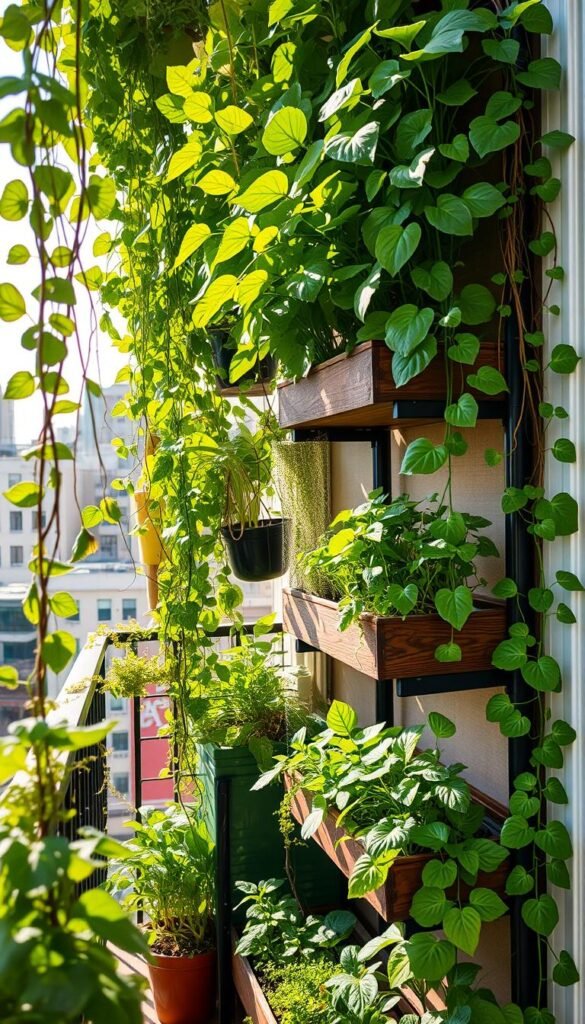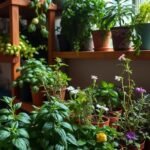City living doesn’t mean giving up fresh greens or homegrown herbs. With creative growing methods, even the tiniest balcony or patio can become a thriving green oasis. Imagine harvesting juicy tomatoes and crisp lettuce steps from your kitchen—no backyard required.
This approach lets you grow 10 times more food in the same square footage compared to traditional plots. Stacked planters turn blank walls into edible displays, while compact hydroponic systems thrive in corners ignored by conventional setups. Best part? You’ll slash grocery bills while reducing your environmental impact through hyper-local harvests.
Major cities already showcase this revolution. Rooftop farms in Chicago supply restaurants year-round, and New Yorkers grow basil in repurposed rain gutters. These methods don’t just feed families—they purify air, soften concrete landscapes, and create habitats for pollinators.
Whether you’re working with a fire escape or a postage-stamp yard, smart design unlocks hidden potential. Modular towers let you mix flowers with veggies, while pocket planters transform fences into salad bars. Ready to rethink what’s possible? Let’s build upward, not outward.
Innovative Vertical Gardening Techniques for Urban Spaces
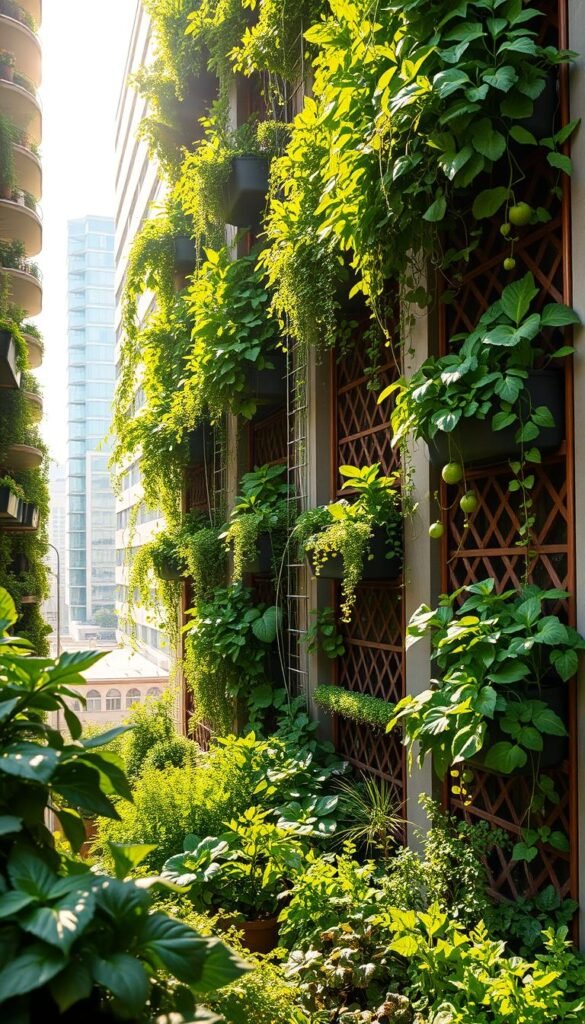
Your concrete jungle can blossom with smart growing solutions that turn blank surfaces into edible masterpieces. Urban dwellers now harvest basil between window AC units and grow cherry tomatoes along fire escapes – proving space limitations spark creativity rather than restrict it.
Maximizing Your Limited Space
Think beyond floor pots. A 4’x6′ wall panel holds 24 plants – equivalent to a 10′ garden row. Boston residents using pocket planters grow 30+ herbs on balcony rails, while San Francisco gardeners stack strawberry towers yielding 25lbs of fruit in 2 sq ft.
| System Type | Plants Supported | Space Used |
|---|---|---|
| Fabric Wall Panels | 30-40/m² | Vertical surfaces |
| Tiered Planters | 15-20 plants | 4 sq ft floor |
| Gutter Gardens | 12-18 linear ft | Wall-mounted |
Creative Structures and Living Walls
Modular systems let you mix flowers with veggies for beauty and function. One Brooklyn gardener transformed a brick wall into a kaleidoscope of purple basil and nasturtiums using interlocking planters. “My living wall cools the apartment and feeds us all summer,” she notes.
These solutions aren’t just pretty – they’re productive. Hydroponic towers grow lettuce 30% faster than soil beds, while aeroponic walls use 90% less water. Your blank wall could become tomorrow’s salad bar.
Designing Your Vertical Garden: Structures and Materials
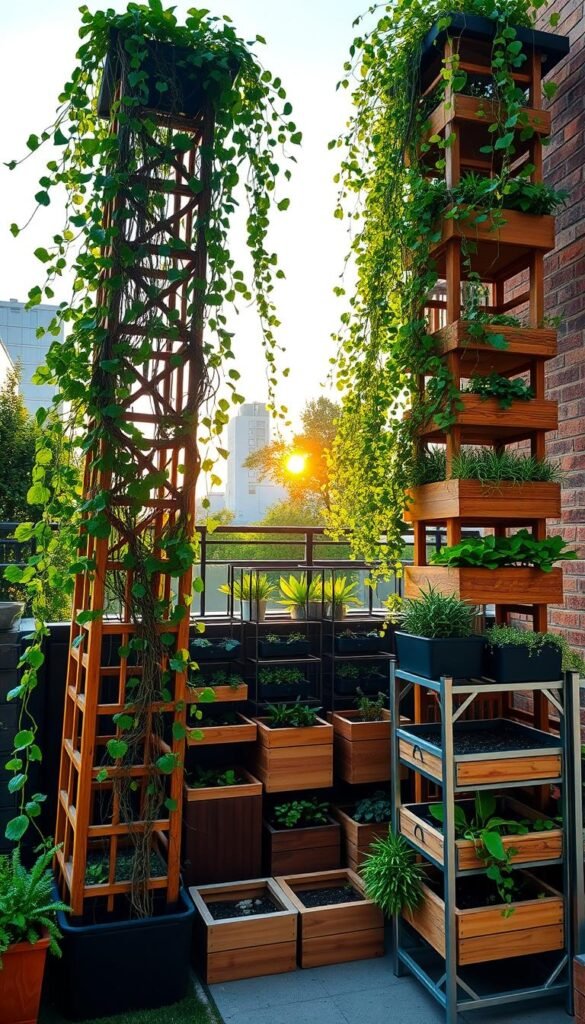
Transform blank walls and tight corners into lush growing spaces with smart structural choices. The right combination of planters and supports turns unused areas into productive green zones.
Trellises, Planters, and Repurposed Wooden Pallets
Stackable towers let you grow 20+ plants in 3 sq ft—perfect for patios. Try fabric pocket systems that hold 12 herbs per yard on fences or exterior walls. Old shipping pallets become instant gardens when stood upright and lined with landscape fabric. One Chicago gardener grew 18 strawberry plants in a single transformed pallet!
Choose materials based on your needs:
| Material | Benefits | Best For |
|---|---|---|
| Bamboo | Renewable, lasts 5+ years | Trellises |
| Reclaimed wood | Eco-friendly, rustic look | Planter boxes |
| Food-grade plastic | Lightweight, waterproof | Pocket systems |
Choosing Sustainable Materials
Opt for bamboo over metal for trellises—it’s stronger than steel by weight and grows back quickly. Use reclaimed barn wood treated with linseed oil instead of pressure-treated lumber. “Natural finishes keep my kale safe while adding character,” notes a Portland urban farmer.
Prioritize drainage and weight limits. Fabric systems work well for renters, while cedar frames suit permanent installations. Your materials should match both your space and values.
Plant Selection Tips for Thriving Vertical Gardens
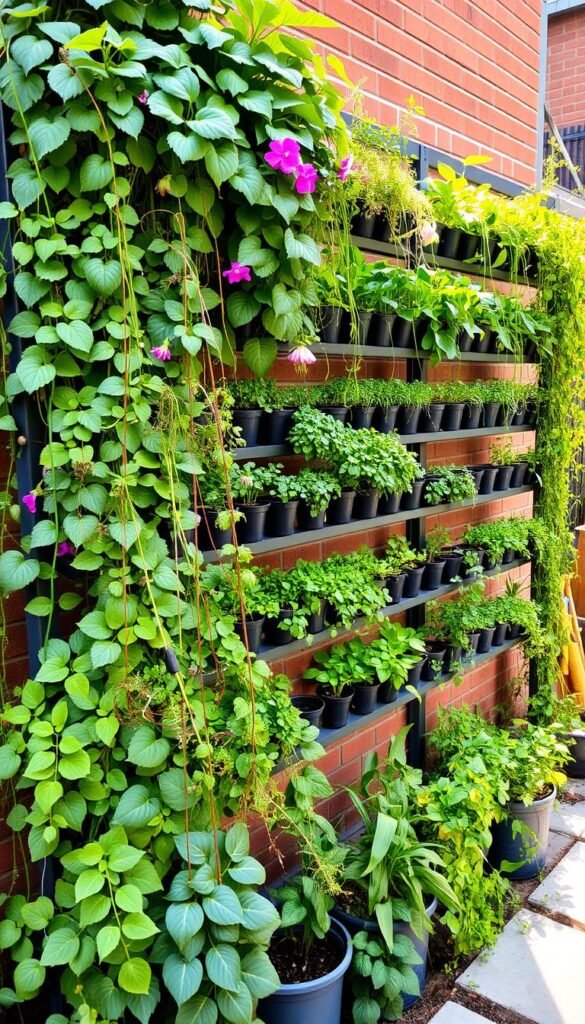
Choosing the right greenery transforms your vertical setup from pretty to productive. Focus on crops that love upward growth and reward you with bountiful harvests in tight spaces.
Best Vegetables and Compact Edibles
Leafy greens dominate vertical systems. Spinach and kale grow happily in shallow soil, giving 3-4 harvests monthly. For fruits, try ‘Tumbling Tom’ tomatoes – these compact vines yield pint-sized snacks perfect for hanging planters.
| Plant Type | Top Varieties | Space Needed |
|---|---|---|
| Leafy Greens | Spinach, Buttercrunch Lettuce | 4-6″ depth |
| Compact Fruits | Tiny Tim Tomatoes, Alpine Strawberries | 8-12″ containers |
| Climbers | Sugar Snap Peas, Dragon Tongue Beans | Vertical trellis |
Herbs, Climbers, and Fruit-Bearing Plants
Rosemary and thyme thrive in wall pockets, releasing fragrance with every breeze. Train cucumber vines upward using top vertical gardening techniques – they’ll produce straighter fruits and resist ground pests.
Don’t overlook strawberries! These juicy gems flourish in tower planters, yielding up to 2lbs per plant. Pair them with nasturtiums for natural pest control and pops of color.
Efficient Watering and Irrigation Solutions
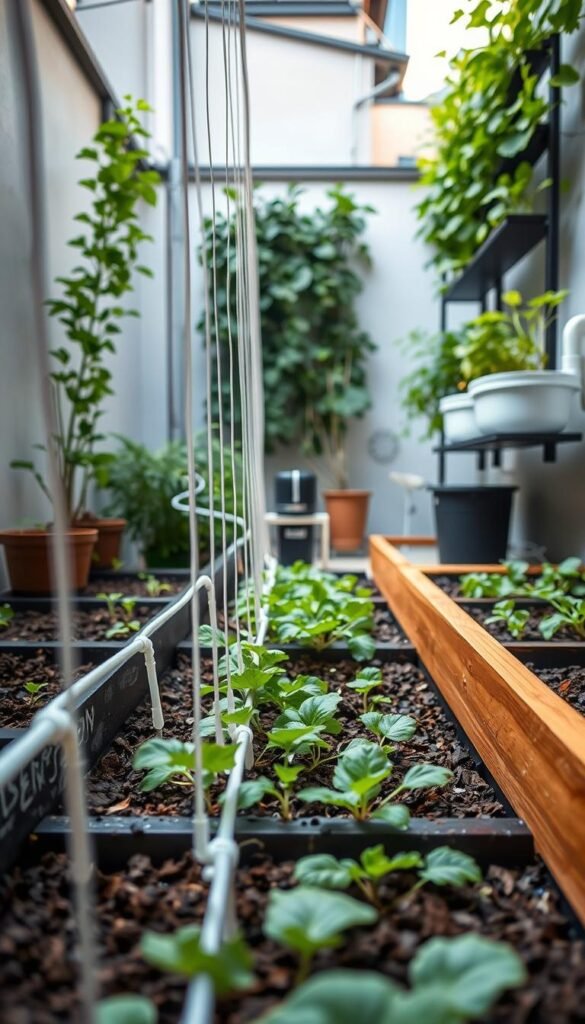
Smart hydration keeps your elevated crops thriving without wasting resources. Modern drip irrigation systems target roots precisely, cutting water use by 70% compared to sprinklers. This approach prevents fungal growth while keeping leaves dry – perfect for tightly packed plant walls.
Drip Irrigation and Self-Watering Designs
Micro-drippers let you customize moisture levels for each plant. Install them along vertical frames to maintain ideal soil conditions. One Seattle gardener reported 40% bigger harvests after switching to targeted watering: “My kale stays perky through heatwaves without constant babysitting.”
Self-watering planters simplify maintenance with built-in reservoirs. These systems use wicking materials to draw moisture upward, sustaining plants for 10-14 days. Perfect for balcony setups – just top up the tank when the indicator turns red.
| System Type | Water Savings | Key Features | Best For |
|---|---|---|---|
| Drip Lines | 65-70% | Adjustable emitters | Trellised plants |
| Self-Watering Planters | 50% | 2-week reservoir | Herb walls |
| Wicking Systems | 45% | No electricity needed | Shallow-root crops |
Automated irrigation systems take the guesswork out of watering. Connect timers to moisture sensors for hands-free care during vacations. Always include proper drainage holes – standing water invites root rot in vertical setups.
Calculate your garden’s needs: most elevated gardening systems require 1-2 gallons daily per square foot. Pair this knowledge with overflow trays to prevent water damage to walls or railings.
Smart Technology and Sustainable Practices in Urban Gardening
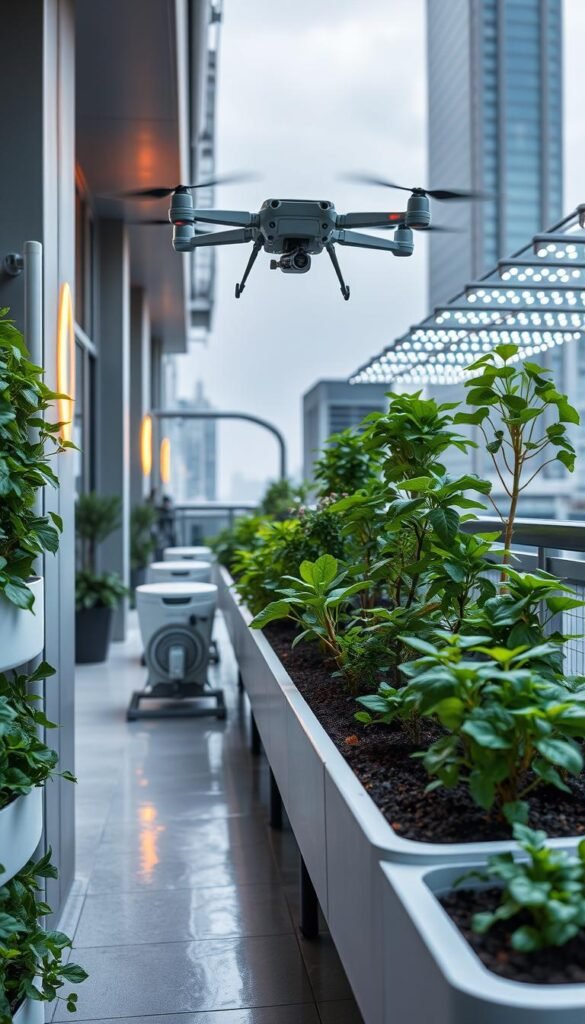
Your green space just got smarter. Today’s systems blend automation with eco-conscious design, turning plant walls into living computers that respond to your crops’ needs. Imagine basil that texts you when it’s thirsty or strawberries receiving perfect light recipes at dawn.
Automated Nutrient Dosing and Moisture Sensors
IoT sensors now monitor soil 24/7, adjusting water flow when levels drop below 15% moisture. One Chicago gardener cut her water bill by 55% using smart valves that only activate during cooler hours. “My lettuce stays crisp without constant checking,” she reports.
Programmable LED panels take guesswork out of lighting. Red wavelengths boost tomato flowering, while blue spectra strengthen leafy greens. Pair these with app-controlled nutrient injectors that adjust fertilizer blends as plants mature – no chemistry degree required.
| Tech Tool | Resource Savings | Yield Increase |
|---|---|---|
| Smart Moisture Sensors | 40-60% water | 18% |
| Auto-Dosing Systems | 30% fertilizer | 22% |
| Adaptive LEDs | 50% energy | 25% |
Swap peat moss for coconut coir – this renewable material holds 10x its weight in water while letting roots breathe. Trials show 28% faster growth in vertical setups using this eco-friendly alternative.
Start small with basic sensors, then expand. Free apps like GrowLink analyze your data to suggest perfect planting times. Soon you’ll harvest plump peppers that practically grew themselves!
Vertical Vegetable Garden: Towering Techniques for Small or Urban Yards
Turn every inch into a powerhouse of fresh flavors through smart design. Vertical gardens deliver 30% bigger harvests than traditional plots while using your walls and railings as prime growing real estate. These space-savvy systems let you pick dinner ingredients while brushing past your thyme-covered balcony rail.
Optimizing Yields with Innovative Systems
Weekly plant checkups keep your green wall thriving. Inspect leaf undersides and stem joints—common pest hideouts. Spring cleaning matters: refresh fabric planters with new soil, and scrub modular systems to prevent disease carryover.
Summer brings thirsty crops. Water twice daily during heat waves, and add support straps for heavy tomato clusters. One Brooklyn gardener boosted yields by 25% using adjustable trellises that grow with plants.
Your pocket planters can outproduce ground beds when managed right. Pair quick-growing lettuce with slow-maturing peppers for constant harvests. Remember: thriving upward gardens need love above and below the leaves!
